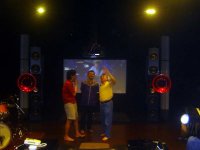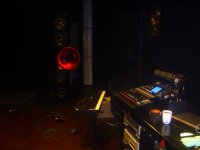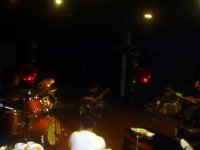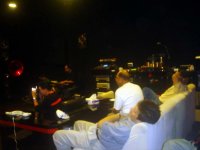Wavebourn said:
It's what I said before: sharp mechanical resonances has to be damped mechanically when possible. But anyway EQ will be needed. The less, the better....................
There has been some research (don't have urls) maybe BBC related that suggested that big Hi Q dips or peaks are less objectionable than small amplitude freq deviations over a broader spectrum. A proffessional recording engineer said to me whilst we were listening to his monitors, "I know these speakers have a peak at 5k but I can work around it". He didn't attempt to correct it as sometimes the cure is worse than the illness.
fredex said:
There has been some research (don't have urls) maybe BBC related that suggested that big Hi Q dips or peaks are less objectionable than small amplitude freq deviations over a broader spectrum. A proffessional recording engineer said to me whilst we were listening to his monitors, "I know these speakers have a peak at 5k but I can work around it". He didn't attempt to correct it as sometimes the cure is worse than the illness.
Right, it depends on how sharp is the peak and what causes it. When I was young and stupid I played a lot with a spectrum analyzer and a pink noise generator. When I made the frequency response flat on the screen electronically it sounded horrible. Why? Look at burst decay waterfall to understand why...
It is not possible to use equalization to correct the combination of direct on axis energy + room reflections. Well, let me refine that statement. You can apply equalization, and that may yield a result that you prefer to listen to, but in doing so one has traded one compromise for another, neither of which is without serious deficits (the unequalized vs. equalized).
Put it simply enough in another way, the equalization that one might apply to a given speaker that "sounds right" in a given (normal) room, will likely not sound right in a room of significantly larger dimensions (forgetting about SPL - if that is an issue).
Attempting to "correct" the frequency response of a given speaker is a different issue and is similarly replreat with all sorts of attendant issues.
What does this have to do with the Blowtorch preamp or even Solid State design? Think we're OT here folks and this bit ought to be spiraled off into a different space if it is to be persued any further?
_-_-bear
PS. I am freqwently incorect alos...
😀
Put it simply enough in another way, the equalization that one might apply to a given speaker that "sounds right" in a given (normal) room, will likely not sound right in a room of significantly larger dimensions (forgetting about SPL - if that is an issue).
Attempting to "correct" the frequency response of a given speaker is a different issue and is similarly replreat with all sorts of attendant issues.
What does this have to do with the Blowtorch preamp or even Solid State design? Think we're OT here folks and this bit ought to be spiraled off into a different space if it is to be persued any further?
_-_-bear
PS. I am freqwently incorect alos...
😀
rdf said:A paradox then. Why should I care if my RIAA correction is within 0.1dB when it's followed by a parametric equalizer in a room where +-3dB would be the proverbial rainbow's pot of gold?
If one had a vynl only system, tweaking the riaa network to get a correct in room response would seem to be a valid purist approach in that you aren't adding more electronics to achieve your goal.
fredex said:Wavebourn
What are your thoughts on Digital Eq ?
Attempt to match response curve to drawn by knobs trading off quality (subharmonics, latency, FM, etc...)?
One more example: BOSE uses them in their active speakers. It's very universal and cheap, but sounds artificial.
One more example: in computer software like ProTools we can forget about latency (it is not a live reproduction), but anyway digital filtering still sound worse. Algorithms?
Now, why you don't ask John why he did not implement digital RIAA correction in his Blowtorch preamp?
Getting direct and reflected responses sorted is not easy and eq'ing the direct response to correct reflected response will be doomed to failure. There are reasons why flat speakers and flat systems tend to sound better even in bad rooms. The speaker room response merge at lower frequencies but can be separated (Haas effect) at higher frequencies.
If recordings were only listed to once the perfection of the performance would be less of an issue, but great recordings are heard many times and mistakes or flawed performances just become more obvious over time. And positioning a microphone in a room is a form of equalization. The magic of the best recording engineers is knowing where to put the mike for the most satisfying sound in the final product. (Not to selecting the right mike in the first place.)
If recordings were only listed to once the perfection of the performance would be less of an issue, but great recordings are heard many times and mistakes or flawed performances just become more obvious over time. And positioning a microphone in a room is a form of equalization. The magic of the best recording engineers is knowing where to put the mike for the most satisfying sound in the final product. (Not to selecting the right mike in the first place.)
Yesterday we did a real comparison between live performance and reproduction sound. To know what the differences are, and what to (or could) be expected from reproduction sound.
Fortunate enough to have a descent Hi-End system (the room+equipment) whose owner support this comparison. Fortunate enough to get a good live performers. To get many panelist.
We try to play and compare same song from CD, LP and live performance.
Preparation :
Fortunate enough to have a descent Hi-End system (the room+equipment) whose owner support this comparison. Fortunate enough to get a good live performers. To get many panelist.
We try to play and compare same song from CD, LP and live performance.
Preparation :
Attachments
Hello,
When I opened this thread, more 3 years ago, I didn't think that it would have this success, today permanent with more than 8000 replies and close to 600 000 views.
A lot of topics, of reflection, of billowy discussions and great publicity for blowtorch and John Curl.
I am amazed that nobody discussed in this thread of the preamplifier presented on this web site .
http://www.moxtone.com/Uskok.htm
It has very numerous resemblance with the Blowtorch:
No global feedback
Double differential input ( H structure ) (untraceable 2SK389V and 2SJ109V are replaced by 2x2SK170BL and 2x2SJ74BL for value Idss)
folded cascode second stage
DC servos for to null out offset output
local power supply (fig2) ( on the PCB of line stages of the Blowtorch )
Differences : pre-regulation, serial regulator and no shunt regulation.
Your opinions???
Darry
When I opened this thread, more 3 years ago, I didn't think that it would have this success, today permanent with more than 8000 replies and close to 600 000 views.
A lot of topics, of reflection, of billowy discussions and great publicity for blowtorch and John Curl.
I am amazed that nobody discussed in this thread of the preamplifier presented on this web site .
http://www.moxtone.com/Uskok.htm
It has very numerous resemblance with the Blowtorch:
No global feedback
Double differential input ( H structure ) (untraceable 2SK389V and 2SJ109V are replaced by 2x2SK170BL and 2x2SJ74BL for value Idss)
folded cascode second stage
DC servos for to null out offset output
local power supply (fig2) ( on the PCB of line stages of the Blowtorch )
Differences : pre-regulation, serial regulator and no shunt regulation.
Your opinions???
Darry
lumanauw said:Some of the panelist
David,
You're quite fortunate to have these possibilities! I think I recognized a familiar face.
Looking forward to hear about the impressions/results.
Jan Didden
Darry,
As I see it the Moxtone is a copy of the Blowtorch with a relay attenuator and doubled up input fets and an inferior power supply, nothing more.
The author seems to not have given Mr.John Curl credit for the original design and now claims a copyright on said design................sad. 🙄
Jam
As I see it the Moxtone is a copy of the Blowtorch with a relay attenuator and doubled up input fets and an inferior power supply, nothing more.
The author seems to not have given Mr.John Curl credit for the original design and now claims a copyright on said design................sad. 🙄
Jam
Darry,
Good to see you back in this thread. Welcome!
Jam,
The Moxtone preamp is not a copy of the Blowtorch, because no-one has seen a copy of the Blowtorch schematic!! As I see it, the Moxtone preamp has been designed with the liberty of building ones own preamp for PERSONAL use. This is still DIY remember! Furthermore I think the designer is entitled to mention on HIS website that HIS interpretation of a resembling topology of the preamp is NOT for commercial use. He shares his design freely and generously in the DIY spirit. I see nothing wrong with that.
Franklin
Good to see you back in this thread. Welcome!
Jam,
The Moxtone preamp is not a copy of the Blowtorch, because no-one has seen a copy of the Blowtorch schematic!! As I see it, the Moxtone preamp has been designed with the liberty of building ones own preamp for PERSONAL use. This is still DIY remember! Furthermore I think the designer is entitled to mention on HIS website that HIS interpretation of a resembling topology of the preamp is NOT for commercial use. He shares his design freely and generously in the DIY spirit. I see nothing wrong with that.
Franklin
Franklin,
Sorry, but if you have read this thread you would understand that Mr.Curl's topology is kind of unique. That being said, changing a few resistors and parts does not make it different.
I see your point about diy but credit should be given where it is due. I could be wrong but Moxtone does not mention Mr.Curl's origional topology and it would not exist had it not been Mr.Curl's work. This has nothing to do with building a unit for one's own use and if someone were to build it for commercial use the rights for it's use should belong to Mr.Curl .
Regards,
Jam
Sorry, but if you have read this thread you would understand that Mr.Curl's topology is kind of unique. That being said, changing a few resistors and parts does not make it different.
I see your point about diy but credit should be given where it is due. I could be wrong but Moxtone does not mention Mr.Curl's origional topology and it would not exist had it not been Mr.Curl's work. This has nothing to do with building a unit for one's own use and if someone were to build it for commercial use the rights for it's use should belong to Mr.Curl .
Regards,
Jam
senior citizen moment
I deleted my post 🙁
Yeah, sorry senior citizen moment of mine.jam said:Tico,
I am sorry but the Aragon topology is totally different. It is based on an earlier Krell design that utilizes n and p channel bipolar differentials, not j-fets. The Aragon circuit does not utilize a folded cascode but a standard VAS.
The Krell topology can be traced back to earlier work by Borgiono, Borboley, Curl and others.
Regards,
Jam
I deleted my post 🙁
Tico,
You are probably not as old as I am so I deleted my post.......😉
My main gripe is that some people don't give credit for someone elses work.
Regards,
Jam
You are probably not as old as I am so I deleted my post.......😉
My main gripe is that some people don't give credit for someone elses work.
Regards,
Jam
- Status
- Not open for further replies.
- Home
- Amplifiers
- Solid State
- John Curl's Blowtorch preamplifier



